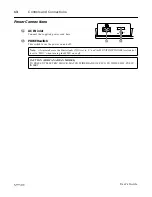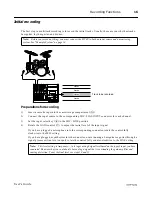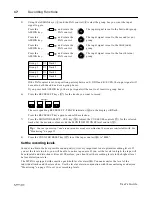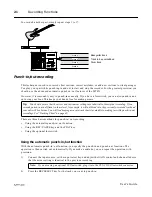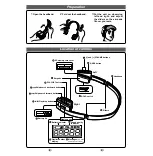
17
Recording Functions
User’s Guide
5)
Using the ASSIGN keys (
4
) and the PAN control (
5
) select the group bus you want the input
signal to go to.
If the PAN control is set to a position partway between L/ODD and R/EVEN, the input signal will
be sent to both the odd and even group buses.
If you press both ASSIGN keys, the input signal will be sent to at least two group buses.
6)
Press the REC SELECT keys (
G
) for the tracks you want to record.
The corresponding REC SELECT - TRACK indicator (
c
) on the display will flash.
Press the REC SELECT key again to cancel the selection.
7)
Press the MONITOR SELECT - CUE key (
0
). Adjust the CUE LEVEL controls (
A
) for the selected
tracks. Set the monitor volume with the MONITOR/PHONES level control (
B
).
8)
Press the COUNTER RESET key (
Q
) to set the tape counter (
Y
) to “0000”.
Set the recording levels
In order to obtain the best possible sound quality, it is very important to set optimal recording levels. If
you set the levels too low, you will be able to notice tape noise. If you set the levels too high, the tape will
be saturated and distortion will result. Therefore, you should set the recording levels to the highest level
before distortion sets in.
The MT4X is equipped with sensitive peak-hold level meters (
Z
). You can monitor the level of the
individual tracks and the stereo bus. Use the level meters in conjunction with the monitoring modes (see
"Monitoring" on page 15) to set your recording levels.
Press the
ASSIGN key:
and rotate the
PAN control:
The input signal is sent to the first (odd) group.
Press the
ASSIGN key:
and rotate the
PAN control:
The input signal is sent to the second (even)
group.
Press the
ASSIGN key:
and rotate the
PAN control:
The input signal is sent to the third (odd)
group.
Press the
ASSIGN key:
and rotate the
PAN control:
The input signal is sent to the fourth (even)
group.
Group 1
→
Track 1
Group 2
→
Track 2
Group 3
→
Track 3
Group 4
→
Track 4
Tip:
You can ignore step 7 and use any monitor mode or combination that you are comfortable with. See
"Monitoring" on page 15.
1
2
1
2
3
4
3
4
REC SELECT
1
2
3
4











